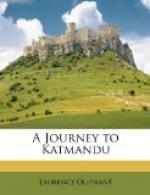My friend Colonel Dhere Shum Shere now came up, whistling the Sturm Marsch, and challenged me to a game of billiards: he was in his manner more thoroughly English than any native I ever knew, and both in appearance and disposition looked as if he was an Anglo-Saxon who had been dyed by mistake. When in Europe he used to dress like an Englishman, and in company with his brother, the Minister Sahib, in similar attire, patronized Vauxhall, Cremorne, and other places of fashionable resort usually frequented by such fast men as they showed themselves to be. Like Jung, he used to say he could not bear the abominable screeching at the Opera, and consequently never made his appearance until the commencement of the ballet, which was much more in their line.
Having profited by his visits to European houses, Jung intends to show his enlightenment by substituting pictures for the articles of vertu with which the walls of his room are at present adorned, and to exchange kitchen ware for albums, in order to prove that he has travelled to some purpose. While examining these table ornaments, I observed a civilized looking little square piece of satin, and on taking it up found I was inspecting the first invitation to Her Majesty’s Opera that had ever reached Nepaul.
In one apartment 700 pounds worth of ladies’ dresses, purchased in England, were spread upon the floor, destined, I presume, to adorn some sable beauties on whom the fashionable flounces of Madame Devy would be anything but becoming.
Jung informed us that a grand ceremony was to take place on the following day. The Queen of England’s letter, of which he was the bearer, was to be read in full Durbar under a salute of twenty-one guns—a greater honour than is shown even to a communication from his Imperial Majesty of the celestial empire.
We accordingly repaired at the appointed hour next morning to the palace of the King, in the great square of Katmandu, and were ushered into the narrow room appropriated to the Durbar. It was hung round with pictures that a tavern would be ashamed of, and altogether looked so dirty that, had it been a tavern, it would have had but little custom.
Seated on a throne were the two Kings gorgeously apparelled and bedizened with jewels, while the Minister Sahib wore nothing but the simple bukkoo, or fur-robe, of great value but unassuming appearance.
There was to be a review of the troops after Durbar, and, as nearly all the nobility of Nepaul hold rank in the army, the whole assemblage was in uniform, certainly one of the most dazzling that I ever saw collected together. Each man had twice as many feathers as he was entitled to wear, and, while their cocked hats were always completely hid, the bodies of the more diminutive officers almost shared the same fate. The English dragoon and the French hussar might here recognize portions of their uniform, adorned with gold and silver lace to an extent which field-marshals alone have, with us, a right to indulge in, and often mixed up with some Oriental finery—a pair of glittering slippers that consorted but ill with the tightly strapped-down gold lace trowsers, or a handsome shawl that clumsily supported the jewelled sabre.




